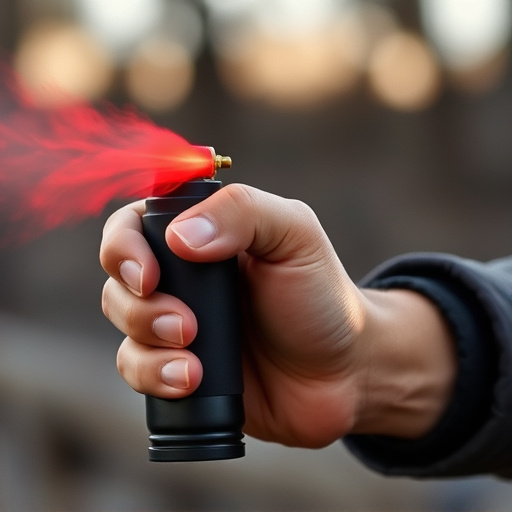OC spray, a popular non-lethal self-defense tool, uses capsaicin from chili peppers to temporarily disable attackers. Concentrations range from 2% to 10%, with higher levels offering better protection but increasing discomfort. This compound acts on vanilloid receptors, causing physiological responses that incapacitate assailants momentarily, allowing individuals to escape or call for help. Effective deployment requires training and familiarity. Understanding capsaicin concentration levels is crucial, as higher concentrations increase disabling potential, but usage depends on factors like application method and individual sensitivity. Consumers should prioritize products with detailed information and be aware of legal variations and regulations regarding OC spray's possession and use.
Personal security is a growing concern, prompting individuals to seek effective self-defense options. One such tool gaining popularity is OC spray, also known as pepper spray. This article explores the power of capsaicin, the active ingredient in OC spray, and its inflammatory properties that deter potential threats. We delve into concentration levels, their significance for personal security, and legal considerations surrounding responsible usage. By understanding these aspects, individuals can make informed decisions about using OC spray as a non-lethal self-defense mechanism.
- Understanding OC Spray: A Non-Lethal Self-Defense Tool
- The Science Behind Capsaicin: Its Inflammatory Properties and Efficacy
- Deciphering Concentration Levels: What Does It Mean for Personal Security?
- Legal Considerations and Responsible Use of OC Spray
Understanding OC Spray: A Non-Lethal Self-Defense Tool
OC spray, short for Oleoresin Capsicum spray, is a non-lethal self-defense tool that has gained popularity among individuals seeking personal security. This pepper spray is designed to temporarily incapacitate an attacker by causing irritation and pain in the eyes, nose, and throat. The primary active ingredient, capsaicin, is extracted from chili peppers and is known for its potent inflammatory properties.
OC spray comes in various forms with different capsaicin concentration levels, typically ranging from 2% to 10%. Higher concentrations offer more protection but also increase the level of discomfort caused. It’s crucial to understand that OC spray is not meant to kill but to disable an assailant long enough for the user to escape or for help to arrive. Proper training and familiarity with its usage are essential to ensure effective deployment in high-stress situations.
The Science Behind Capsaicin: Its Inflammatory Properties and Efficacy
The Science Behind Capsaicin: Unlocking Its Inflammatory Properties and Efficacy in Personal Security
Capsaicin, the active ingredient found in chili peppers, is a powerful compound that has gained significant attention in personal security products. Its unique ability to induce a burning sensation in humans is not just a culinary curiosity; it serves as the cornerstone of many self-defense mechanisms. When incorporated into OC spray at specific concentration levels, capsaicin becomes an effective deterrent. The high OC Spray Capsaicin Concentration Levels ensure that even brief exposure can cause immediate discomfort and disorientation in potential assailants, providing users with valuable time to escape or seek help.
The inflammatory properties of capsaicin are well-documented. It interacts with the body’s vanilloid receptors, particularly TRPV1, which are responsible for sensing heat and pain. This interaction leads to a cascade of events, including increased heart rate, sweating, and respiratory distress in the target. In the context of personal security, these physiological responses act as powerful non-lethal force multipliers, enabling individuals to protect themselves effectively while minimizing harm.
Deciphering Concentration Levels: What Does It Mean for Personal Security?
Understanding capsaicin concentration levels, such as those found in OC spray, is paramount for personal security. These levels, typically measured in percent or milligrams per liter, represent the potency of the irritant and its effectiveness as a self-defense tool. Higher concentrations mean stronger irritation and potential incapacitation of an attacker, providing users with a crucial advantage in dangerous situations.
However, simply knowing the concentration isn’t enough. Factors like application method, duration of contact, and individual sensitivity play significant roles in the spray’s effectiveness. Therefore, consumers should look for products with clear labeling and seek training on proper usage to ensure optimal protection and safety when relying on OC spray as a personal security measure.
Legal Considerations and Responsible Use of OC Spray
The legal landscape surrounding the use of OC spray, also known as pepper spray, varies across jurisdictions worldwide. In many countries, it is strictly regulated and can only be possessed and used by authorized individuals, such as law enforcement officers or security personnel. The laws often dictate specific OC spray capsicin concentration levels permitted for civilian use, with lower concentrations typically allowed for self-defense purposes. Compliance with these regulations is crucial to avoid legal repercussions.
Responsible use involves understanding the spray’s limitations and effects. OC spray temporarily incapacitates an assailant by irritating the eyes, nose, and respiratory system due to its capsaicin content. However, it should be employed as a last resort when facing an imminent threat. Users must also be aware of the legal consequences of misusing or recklessly deploying the spray, which can vary from fines to criminal charges, depending on local laws and the circumstances surrounding its use.
OC Spray, powered by capsaicin, has emerged as a valuable personal security tool. Understanding its non-lethal nature, the science behind its inflammatory properties, and the significance of concentration levels is crucial for effective and responsible use. By knowing what OC spray is, how it works, and the legal considerations involved, users can make informed decisions to enhance their personal safety. The key lies in choosing the right concentration levels to deter threats while adhering to legal guidelines.
